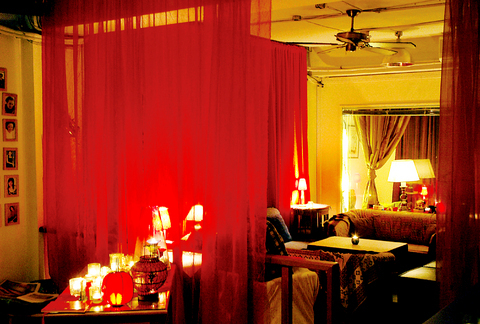A home for experimental musicians, dancers and performers, the Living Room offers a venue for artists to create and visitors to appreciate alternative entertainment. It's not a new spot, having been around since 1999, but in the last year both its interior design and nightly scheduling have been overhauled.
Started by US musician Corbett Wall as a pet project, the restaurant/lounge began as a site for struggling musicians to rehearse and perform. "After a while people started asking if they could have a beer when rehearsing or watching the show. Later, they'd ask if Irene [his wife] could make them something to eat. I guess things just sort of fell into place after that ?. Before I knew it I had a bar," Wall said.

PHOTO COURTESY OF ASHLEY PENG
With experience as both a well-known saxophone player and producer, Wall doesn't have difficulty drawing a crowd. Likewise, his acquaintances in the media and music industry provide valuable contact opportunities for up-and-coming performers who make use of his stage.
The revamped monthly format aims to offer diverse entertainment every night of the week. From Monday's hot pot dinner and live jazz to foreign films, spoken word, performance art and dance, Wall doesn't want to limit the venue to one genre.
He books shows a month in advance but is always open to new talent. In fact, he hopes to attract more experimental and alternative performers. "I want creative people to have a space and be able to try out new things. This is more than just a bar; we are trying to promote an artistic lifestyle," he said.
The Web site is a free call for musicians and artists who want to register to use the space. Basically those with a band play or develop a concept for an event and pitch the idea to Wall, who seldom turns people away. Performers are given a room to entertain and one hundred percent of the door, if they charge a cover. The venue in turn charges a NT$300 minimum fee per person, which guarantees two drinks. It's a slight turnoff to those only interested in seeing the band but it is a small price to pay for live entertainment.
Other transformations include the addition of Aliang, former proprietor of Aliang and Friends, as a co-manager. The Taiwanese artist joined Wall and his wife in December bringing with her a collection of artist friends.
Often seen mixing drinks behind the bar, Aliang and her influence will be more visible when plans to take over the second floor materialize this spring. If everything goes according to plan, the extra floor will be used as a visual art space and restaurant to allow the performance area on the current floor to be expanded.
Still, some things never change. The restaurant's menu continues to offer the same home-cooked food at reasonable prices. Instead of choosing from a menu, customers offer up their dislikes and budget. The chef then prepares them a suitable meal.
The Living Room will take a one-week Lunar New Year holiday, beginning this Sunday. It will re-open with Mandarin rockabilly music from Sugar Lady on Valentine's Day (February 14).
The Living Room is located at 3 Fl, 8 Nanjing E Rd, Sec 5, Taipei (南京東路5段8號3樓). It is open daily from 6:30pm to 1am. For details on upcoming events or bookings check the website at www.livngroomtaipei.com

A vaccine to fight dementia? It turns out there may already be one — shots that prevent painful shingles also appear to protect aging brains. A new study found shingles vaccination cut older adults’ risk of developing dementia over the next seven years by 20 percent. The research, published Wednesday in the journal Nature, is part of growing understanding about how many factors influence brain health as we age — and what we can do about it. “It’s a very robust finding,” said lead researcher Pascal Geldsetzer of Stanford University. And “women seem to benefit more,” important as they’re at higher risk of

March 31 to April 6 On May 13, 1950, National Taiwan University Hospital otolaryngologist Su You-peng (蘇友鵬) was summoned to the director’s office. He thought someone had complained about him practicing the violin at night, but when he entered the room, he knew something was terribly wrong. He saw several burly men who appeared to be government secret agents, and three other resident doctors: internist Hsu Chiang (許強), dermatologist Hu Pao-chen (胡寶珍) and ophthalmologist Hu Hsin-lin (胡鑫麟). They were handcuffed, herded onto two jeeps and taken to the Secrecy Bureau (保密局) for questioning. Su was still in his doctor’s robes at

Last week the Democratic Progressive Party (DPP) said that the budget cuts voted for by the China-aligned parties in the legislature, are intended to force the DPP to hike electricity rates. The public would then blame it for the rate hike. It’s fairly clear that the first part of that is correct. Slashing the budget of state-run Taiwan Power Co (Taipower, 台電) is a move intended to cause discontent with the DPP when electricity rates go up. Taipower’s debt, NT$422.9 billion (US$12.78 billion), is one of the numerous permanent crises created by the nation’s construction-industrial state and the developmentalist mentality it

Experts say that the devastating earthquake in Myanmar on Friday was likely the strongest to hit the country in decades, with disaster modeling suggesting thousands could be dead. Automatic assessments from the US Geological Survey (USGS) said the shallow 7.7-magnitude quake northwest of the central Myanmar city of Sagaing triggered a red alert for shaking-related fatalities and economic losses. “High casualties and extensive damage are probable and the disaster is likely widespread,” it said, locating the epicentre near the central Myanmar city of Mandalay, home to more than a million people. Myanmar’s ruling junta said on Saturday morning that the number killed had